Mycoplasmas are small, hard to detect bacteria that can infect and contaminate cell cultures. Scientists have been increasingly working to develop products and methodologies that prevent their spread.
 Image Credit: AshTproductions / Shutterstock
Image Credit: AshTproductions / Shutterstock
Cell cultures are increasingly used in both research and biotechnology. While they offer valuable insight into cell physiology and are a good alternative to animal models, they have, in recent decades, been proven to be vulnerable to contamination.
Mycoplasma commonly infect cell cultures within incubators and easily spread between cultures. Mycoplasma contamination is therefore regarded as a highly serious issue in most laboratories.
Mycoplasma physiology
The most striking feature of mycoplasma is that they lack a rigid cell wall. Given that many antibiotics work by preventing cell wall synthesis, mycoplasma are innately immune to such treatment.
They are also among the smallest bacteria ever found, which enables them to pass through bacterial filters otherwise used to prevent bacterial spread.
It was previously believed that mycoplasma only existed on the surface of eukaryotic cells, but they have been discovered intracellularly. The majority are located extracellularly.
However, certain species have been discovered in granulocytes and monocytes, after phagocytosis, but also inside epithelial cells through non-phagocytotic pathways. The occasional intracellular location may protect them from mycoplasmacidal therapies.
Detecting mycoplasma in cell cultures
A myriad of detection methods exist for mycoplasmas in cell culture. Some of these are non-specific, such as DNA-binding flourochromes, histological stains, and electron microscopy. Before these approaches, polymerase chain reaction (PCR), DNA staining and microbiological cultures were the commonly used methods.
DNA-staining of mycoplasma involves a dye binding DNA, which can reveal stains of mycoplasma growth. Although this method is cheap and quick, its lack of precision means it is no longer preferred. The specificity of PCR is appealing, as knowing the type of mycoplasma the cell culture is infected with can be beneficial for future prevention methods.
Microbiological colony assays were the gold standard for mycoplasma detection for decades before the advent of PCR. In colony assays, samples from cell cultures are inoculated into mycoplasma broth and onto agar 4-7 days after inoculation. They are preferentially kept aerobically to support growth.
If mycoplasmas are present, they will form colonies in the shape of a fried egg; two visible circles, one inside the other. The advantages of this method include its ease of use and the visual identification of colonies.
However, the incubation time required is quite long (4-7 days), and the visual inspection relies on experienced staff. It is also possible that this method misses some mycoplasma infections, since not all species can be cultured successfully.
PCR was first used to identify mycoplasma in 1989. Mycoplasma have certain regions of their genome which are highly conserved, meaning there are universal primers to detect any mycoplasma species.
Some are even applicable to detect any prokaryotes. These are suitable when screening for contamination, but there are also intergenic regions (16S-23S) which can be used for both detection and identification.
Despite the high sensitivity of PCR, there are occasional mistakes. Because PCR is so highly sensitive, it is at risk for producing false-positives due to DNA contamination. It can also give false-negatives due to Taq polymerase inhibition by the sample itself.
However, PCR offers the most time effective and high sensitivity method available for detection of mycoplasma in cell cultures.
Cell Contamination: What you may be overlooking
Preventing mycoplasma contamination
Once one culture in a laboratory has been contaminated, the mycoplasma can spread to the other cultures. This is one of the most common sources of mycoplasma contamination, along with contaminated serum and contamination from laboratory staff. Therefore, most prevention methods center around these sources.
Mycoplasmas have been shown to be sensitive to most disinfectants. Because of this, sterile cell culture work should be conducted in a fume hood with disinfected surfaces and devices. Specifically, a vertical laminar-flow biohazard fume hood is recommended.
Regular cleaning of other surfaces in the laboratory, such as sinks and floors, should be conducted to minimize environmental contamination.
To avoid contaminated serum or other reagents, these should only be purchased from trustworthy suppliers.
Suppliers should be testing their products for mycoplasma contamination, and the receiving laboratory is encouraged to quarantine incoming products until their contamination status is established.
An existing mycoplasma contamination can be hard to eliminate. They are not susceptible to most antibiotics, can’t be filtered out, and can even sometimes “hide”. Widespread regular use of antibiotics targeting mycoplasma is not recommended, for fear of resistant bacteria.
The most effective and reliable way of preventing mycoplasma from spreading is to eliminate samples where it is found.
Further Reading
Last Updated: Feb 26, 2019